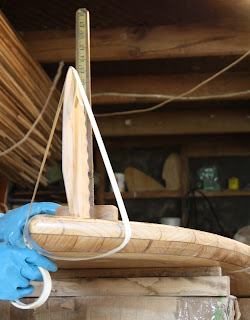Installation of the 12" Spitfire cuataway tubercule fin for the 10'6" Earl. A 2" deep slot (which fits the fin exactly) is made in the surfboard. It's a very sturdy method of attaching the fin as the fin becomes an integral part of the board. It also allows the fillet at the fin base to be the optimal size for water flow, as a structural fillet isn't required.
Checking that the elliptical planform planar foil is set 'plumb'.
Here the smooth relatively even curve produced by the 50/50 position of the chord or thickest part of the fin can be seen. A 50/50 foil gives a more accurate response to turning and trimming input from the rider than the commonly used foil sections which have their chord positions further forward. Moving the chord position aft also reduces drag, and even though the angle of attack capability of the fin is somewhat reduced, this is overcome via a slightly thicker foil and leading edge tubercules. This fin has proven itself to be a truly outstanding performer without leading edge tubercules, and promises to be even better with them added.
Prior to adding the 4mm diameter filet at the fin base, the excess epoxy and paulownia dust marine glue is carefully scraped away. Later a bead of clear resin will be used to make the fillet, the surface tension of the resin making a perfect half round fillet without any hand shaping.
The Earl's torpedo like parallel profile displacement tail, a concept thankfully not yet understood by the surfing world at large who continue to think that the term 'displacement' applies only to a class of outdated thin railed slightly convex bottomed boards known erroneously as 'displacement hulls'. The great functional beauty and subtleties of the displacement tail are known only to a few, it's a taste acquired only by experience.
The oblique plank lines suggest water flow...






